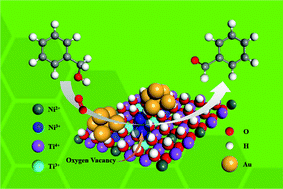Defect-rich Ni–Ti layered double hydroxide as a highly efficient support for Au nanoparticles in base-free and solvent-free selective oxidation of benzyl alcohol
Abstract
Tuning the surface properties of supported metal catalysts is of vital importance for governing their catalytic performances in nanocatalysis. Here, we report highly dispersed nanometric gold nanoparticles (NPs) supported on Ni–Ti layered double hydroxides (NiTi-LDHs), which were employed in solvent-free and base-free selective oxidation of benzyl alcohol. A series of characterization techniques demonstrated that defect-rich NiTi-LDHs could efficiently stabilize Au NPs and decrease surface electron density of Au NPs. The as-formed Au/NiTi-LDH catalyst with a Ni/Ti molar ratio of 3 : 1 and an Au loading of 0.71 wt% yielded the highest turnover frequency value of ∼4981 h−1 at 120 °C among tested Au/NiTi-LDH catalysts with different Ni/Ti molar ratios, along with a high benzaldehyde selectivity of 98%. High catalytic efficiency of the catalyst was mainly correlated with surface cooperation between unique defects (i.e. defective Ti3+ species and oxygen vacancies) and abundant hydroxyl groups on the brucite-like layers of the NiTi-LDH support, which could lead to the preferential adsorption and activation of an alcohol hydroxyl moiety in benzyl alcohol and oxygen molecule, as well as the formation of more electron-deficient Ni3+ and Au0 species on the catalyst surface. Furthermore, the present Au/NiTi-LDH catalyst tolerated the oxidation of a wide variety of substrate structures into the corresponding aldehydes, acids or ketones. Our primary results illustrate that defect-rich NiTi-LDHs are promising supports which can efficiently modify surface structure and electronic properties of supported metal catalysts and consequently improve their catalytic performances.



 Please wait while we load your content...
Please wait while we load your content...